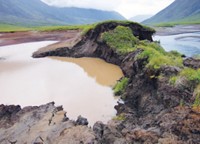Advertisement
Grab your lab coat. Let's get started
Welcome!
Welcome!
Create an account below to get 6 C&EN articles per month, receive newsletters and more - all free.
It seems this is your first time logging in online. Please enter the following information to continue.
As an ACS member you automatically get access to this site. All we need is few more details to create your reading experience.
Not you? Sign in with a different account.
Not you? Sign in with a different account.
ERROR 1
ERROR 1
ERROR 2
ERROR 2
ERROR 2
ERROR 2
ERROR 2
Password and Confirm password must match.
If you have an ACS member number, please enter it here so we can link this account to your membership. (optional)
ERROR 2
ACS values your privacy. By submitting your information, you are gaining access to C&EN and subscribing to our weekly newsletter. We use the information you provide to make your reading experience better, and we will never sell your data to third party members.
Environment
Soils Of Northern U.S. Forests Are High In Mercury
Pollution: Carbon-rich northern soil may sequester the toxic metal
by Sara Peach
April 19, 2011

The carbon-rich soils in northern U.S. forests contain up to 16 times as much mercury as do soils in southern forests, according to a new study conducted in 10 states (Environ. Sci. Technol., DOI: 10.1021/es104384m).
Between 5,000 and 8,000 tons of mercury, a toxic metal, enter the atmosphere annually, according to the Environmental Protection Agency. While natural sources, such as volcanoes, emit some of the mercury, much of it originates from industrial sources, such as coal-burning power plants. Some of the mercury settles in forests, where trees, leaf litter, and soil absorb it.
Anthropogenic mercury has accumulated in forests since the Industrial Revolution. As a result, scientists suspect that globally, forests could store tens to hundreds of thousands of tons of the metal, says the study's lead author, Daniel Obrist, an associate research professor at the Desert Research Institute, the environmental research arm of the Nevada System of Higher Education.
But researchers know little about the geographical distribution of those mercury deposits, Obrist says. Nor do they have a clear understanding of whether a warming climate could cause that mercury to cycle more quickly into the atmosphere. Scientists want to understand mercury's fate because it can wash from the atmosphere or from forest floors to water bodies, where it can accumulate in the aquatic food chain.
So Obrist's team conducted a systematic inventory of mercury concentrations in 14 forests across the continental U.S. They collected 12 soil samples from each forest. In the lab, the researchers freeze-dried and milled the samples. Then, they analyzed the samples' mercury and carbon concentrations.
The researchers found that, in general, soils at higher latitudes contained more mercury than those at lower latitudes. For example, mercury concentrations were an average of 16 times higher in soil samples collected from a forest in Howland, Maine, than they were in samples from Gainesville, Fla. The researchers think that the low latitudes' greater sun exposure, which can cause mercury evaporation, shortens the metal's lifetime in southern soils and could drive migration of the metal from south to north.
Greater mercury concentrations also correlated with higher carbon content, likely because mercury often binds to organic molecules, Obrist says. High carbon levels may help explain why northern forest soils contain more mercury, he says. In cool climates, organic matter decomposes slowly, which may enable mercury to accumulate in the soil, he says.
But climate change could disrupt this pattern, says Sue Natali, a postdoctoral fellow in the biology department at the University of Florida. Rising temperatures could speed decomposition rates, leading mercury to escape to the atmosphere and to eventually pollute water bodies.
That process could be a particular concern at northern latitudes, which are warming more quickly than the rest of the globe, Obrist says. Research on this question should continue, he says: "We have very, very little experimental data that shows what actually happens with mercury if we lose the carbon."





Join the conversation
Contact the reporter
Submit a Letter to the Editor for publication
Engage with us on Twitter